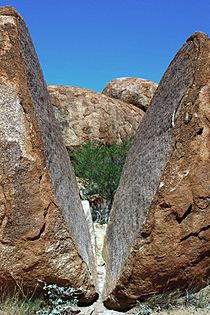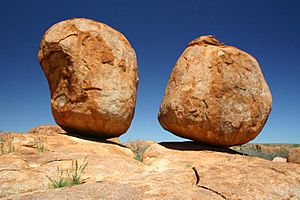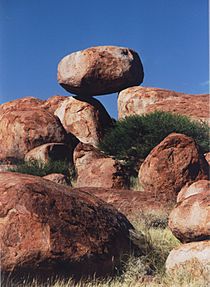Karlu Karlu / Devils Marbles Conservation Reserve facts for kids
Quick facts for kids Karlu Karlu / Devils Marbles Conservation ReserveWarumungu, Northern Territory |
|
|---|---|
|
IUCN Category V (Protected Landscape/Seascape)
|
|
| Nearest town or city | Wauchope |
| Established | October 1961 |
| Area | 18.02 km2 (7.0 sq mi) |
| Visitation | 137,500 (in 2012) |
| Managing authorities | Traditional Aboriginal Owners and the Parks and Wildlife Commission of the Northern Territory |
| Website | Karlu Karlu / Devils Marbles Conservation Reserve |
| See also | Protected areas of the Northern Territory |
The Karlu Karlu / Devils Marbles Conservation Reserve is a special protected area in Australia's Northern Territory. It is located in a place called Warumungu. This reserve is about 105 km (65 miles) south of Tennant Creek. It is also 393 km (244 miles) north of Alice Springs. The closest small town is Wauchope, which is only 9 km (5.6 miles) away.
The amazing rock formations here are called the Devils Marbles. They are very important to the Aboriginal people who have lived on this land for a very long time. The reserve helps protect one of the world's oldest religious sites. Karlu Karlu is the local Aboriginal name for these rocks and the land around them. It means round boulders.
The English name "Devils Marbles" came from an explorer named John Ross. In 1870, he said, "This is the Devil’s country; he’s even emptied his bag of marbles around the place!"
This area was first called Devils Marbles Reserve in October 1961. Later, in 2008, the land was officially given back to the Traditional Aboriginal Owners. Now, the reserve is managed together by the Traditional Owners and the Parks and Wildlife Service. This means it is an Indigenous Protected Area. In 2011, the name was changed to Karlu Karlu / Devils Marbles Conservation Reserve to show this shared management.
Amazing Rock Formations
The Devils Marbles are huge granite rocks. They are the top part of a much larger rock formation that is mostly underground. Over millions of years, natural forces like weathering and erosion have shaped these rocks into their unique forms. Some of these giant boulders are amazingly balanced on top of each other. Others have been split perfectly in half by nature.
You can find these boulders scattered across a wide, shallow desert valley. Most of them are on the western side of the reserve. A short road from the Stuart Highway leads right into the area where the boulders are.
The Devils Marbles are a famous symbol of Australia's outback. Many people visit this reserve every year. In 2012, about 137,500 people came to see them. The best time to visit is during the cooler months, from May to August. The reserve is easy to reach from the Stuart Highway, which is a main road connecting Darwin and Alice Springs.
You can visit the Devils Marbles all year round. There are pathways, information signs, and a basic camping area. Park rangers also offer special events and programs from May to September each year.
Aboriginal Significance
Karlu Karlu is very important to the local Aboriginal people. Most of the reserve is a Registered Sacred Site. This means it is protected under special laws. Even though Karlu Karlu is in the land of the Alyawarre people, other local Aboriginal groups also have strong spiritual connections to this area. These groups include the Kaytetye, Warumungu, and Warlpiri people.
Many traditional Dreaming stories are connected to Karlu Karlu. These stories explain how the land and its features were created. They are passed down through generations of Traditional Owners. These stories are not about mythical serpents, but about other important events and beings. Only some of these stories are shared with visitors.
One main Dreaming story that can be told to the public explains how Karlu Karlu was formed. This story tells of Arrange, the Devil Man. He traveled through the area and made a special belt from hair. As he was making the belt, he dropped clumps of hair on the ground. These clumps turned into the famous big red boulders of Karlu Karlu. On his way back, Arrange spat on the ground, and his spit became the granite boulders in the middle of the reserve. Arrange then returned to his home, a hill called Ayleparrarntenhe, where he stays today.
How the Marbles Formed
The Devils Marbles are made of granite. They are like small rock islands in the desert, surrounded by a lot of sandstone. The granite formed millions of years ago deep inside the Earth. It was created when hot, melted rock (magma) cooled down and became hard. Thick layers of sandstone on top pushed down on the granite with great force.
Later, movements in the Earth's crust caused the land to fold and lift. This brought the granite closer to the surface. As the pressure from above lessened, the granite expanded. This caused cracks to form, breaking the large granite mass into big, square blocks.
The next step in the formation of the Marbles happened when these blocks were exposed to water. The surface of the blocks started to break down. A layer of loose material formed around each block. When the blocks finally reached the surface, this loose material was washed away by water and blown away by wind.
The round shape of the granite blocks is due to chemical and physical weathering. Chemical processes cause the surface of the rocks to expand and shrink. This makes thin layers of rock peel off, like layers of an onion. This process is called exfoliation. It makes the blocks round because the edges wear away faster.
The extreme temperature changes between day and night in the desert also affect the boulders. During the day, the rocks get hot and expand a little. At night, they cool down and shrink a little. This happens every day. These repeated changes, called thermal stress weathering, create cracks. Sometimes, these cracks go so deep that they split a boulder completely in half.
See also
 In Spanish: Karlu Karlu para niños
In Spanish: Karlu Karlu para niños






